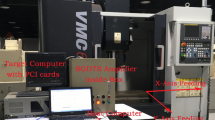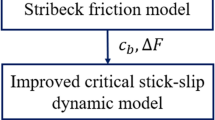Abstract
Friction exists in the feed drive servomechanisms of CNC machine tools and usually affects their motion. Although many experiments have been performed to identify the friction characteristics of a feed drive servomechanism, problems such as unmodeled dynamics and position-dependent perturbations still exist and significantly affect the friction identification results. In this study, in order to obtain reliable friction and velocity data values, a modified velocity control system is developed to reduce the effects induced by unmodeled dynamics, and a friction extraction method is developed to remove the adverse effects of position-dependent perturbations. Furthermore, several experiments and motion tests are carried out on a three-axis CNC milling machine to demonstrate the feasibility of the proposed friction identification method. The experimental results indicate that the friction-compensated motion control system with the friction model obtained in this study reduces the root mean square value of tracking errors by 44.16%. Moreover, as compared to a conventional identification method, the root mean square value of tracking errors is found to further reduce by 9.52% in the experiments.
Similar content being viewed by others
References
Tsai MC, Chiu IF, Cheng MY (2004) Design and implementation of command and friction feedforward control for CNC motion controllers. IEE Proc Control Theory Appl 151(1):13–20
Elfizy AT, Bone GM, Elbestawi MA (2004) Model-based controller design for machine tool direct feed drives. Int J Mach Tools Manuf 44(5):465–477
Shih YT, Lee AC (2003) Survey on modeling and control for motion systems with friction. Journal of the Chinese Society of Mechanical Engineers, Transactions of the Chinese Institute of Engineers, Series C 24(4):337–352
Armstrong-Helouvry B, Dupont P, Canudas-de-Wit C (1994) A survey of models, analysis tools and compensation methods for the control of machines with friction. Automatica 30(7):1083–1138
Yeh SS, Tsai ZH, Hsu PL (2009) Applications of integrated motion controllers for precise CNC machines. Int J Adv Manuf Technol 44(9–10):906–920
Mei ZQ, Xue YC, Yang RQ (2006) Nonlinear friction compensation in mechatronic servo systems. Int J Adv Manuf Technol 30(7–8):693–699
Chen JS, Kuo YH, Hsu WY (2006) The influence of friction on contouring accuracy of a Cartesian guided tripod machine tool. Int J Adv Manuf Technol 30(5–6):470–478
Awrejcewicz J, Olejnik P (2005) Analysis of dynamic systems with various friction laws. Appl Mech Rev 58(1–6):389–410
Chen CL, Jang MJ, Lin KC (2004) Modeling and high-precision control of a ball-screw-driven stage. Precis Eng 28(4):483–495
Persianoff R, Ray P, Vidal O (2003) Comparison between an experimental study and a numerical model of the dynamic behaviour of machine-tool slideways. Proc Inst Mech Eng B J Eng Manuf 217(8):1111–1115
Hsieh C, Pan YC (2000) Dynamic behavior and modelling of the pre-sliding static friction. Wear 242(1–2):1–17
Polycarpou AA, Soom A (1996) A two-component mixed friction model for a lubricated line contact. Journal of Tribology, Transactions of the ASME 118:183–189
Cetinkunt S, Yu WL, Filliben J, Donmez A (1994) Friction characterization experiments on a single point diamond turning machine tool. Int J Mach Tools Manuf 34(1):19–32
Marui E, Endo H (1992) Significance of contact resistance in boundary lubrication. Wear 156(1):49–55
Armstrong-Helouvry B (1991) Control of machines with friction. Kluwer, Boston
Armstrong BSR, Chen Q (2008) The Z-properties chart. IEEE Control Syst Mag 28(5):79–89
Cheok KC, Hu H, Loh NK (1988) Modeling and identification of a class of servomechanism systems with stick-slip friction. Journal of Dynamic Systems, Measurement and Control, Transactions of the ASME 110(3):324–328
Karnopp D (1985) Computer simulation of stick-slip friction in mechanical dynamic systems. Journal of Dynamic Systems, Measurement and Control, Transactions of the ASME 107(1):100–103
Kim JH, Chae HK, Jeon JY, Lee SW (1996) Identification and control of systems with friction using accelerated evolutionary programming. IEEE Control Syst Mag 16(4):38–47
Canudas-de-Wit C, Lischinsky P (1997) Adaptive friction compensation with partially known dynamic friction model. Int J Adapt Control and Signal Process 11(1):65–80
Canudas-de-Wit C, Olsson H, Astrom KJ, Lischinsky P (1995) A new model for control of systems with friction. IEEE Trans Automat Contr 40(3):419–425
Popovic MR, Goldenberg AA (1998) Modeling of friction using spectral analysis. IEEE Trans Robot Autom 14(1):114–122
Ohnishi K (1987) A new servo method in mechatronics. Transactions of the Japan Society for Electrical Engineering 107(D):83–86
Matsushita Co. (2004) Panasonic MINAS A4-series instruction manual (DV0P4210). Matsushita Electric Industrial Co., Ltd
Söderström T, Stoica P (1989) System identification. Prentice Hall, New York
Choi BK, Choi CH, Lim K (1999) Model-based disturbance attenuation for CNC machining centers in cutting process. IEEE/ASME Trans Mechatron 4(2):157–168
Lee HS, Tomizuka M (1996) Robust motion controller design for high accuracy positioning systems. IEEE Transactions on Industrial Electronics 43:48–55
Umeno T, Hori Y (1991) Robust speed control of servomotors using modern two degrees-of-freedom controller design. IEEE Transactions on Industrial Electronics 38:363–368
Oppenheim AV, Schafer RW (1989) Discrete-time signal processing. Prentice Hall, New York
Garcia E, De-Santos PG, Canudas-de-Wit C (2002) Velocity dependence in the cyclic friction arising with gears. Int J Rob Res 21(9):761–771
Lischinsky P, Canudas-de-Wit C, Morel G (1999) Friction compensation for an industrial hydraulic robot. IEEE Control Syst Mag 19(1):25–32
Grace A (1994) Optimization toolbox for use with MATLAB, user’s guide. The MathWorks Inc.
Dahl PR (1976) Solid friction damping of mechanical vibrations. AIAA J 14(12):1675–1682
Kato S, Yamaguchi K, Matsubayashi T (1974) Stick-slip motion of machine tool slideway. Journal of Engineering for Industry, Transactions of the ASME 96(2):557–566
Author information
Authors and Affiliations
Corresponding author
Rights and permissions
About this article
Cite this article
Yeh, SS., Su, HC. Development of friction identification methods for feed drives of CNC machine tools. Int J Adv Manuf Technol 52, 263–278 (2011). https://doi.org/10.1007/s00170-010-2720-5
Received:
Accepted:
Published:
Issue Date:
DOI: https://doi.org/10.1007/s00170-010-2720-5




